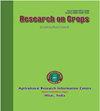利用 28S rDNA 鉴定南非林波波省番茄幼苗(Solanum lycopersicum)的分子特征
Q3 Agricultural and Biological Sciences
引用次数: 0
摘要
在南非种植番茄(Solanum lycopersicum)可以获得丰厚的利润,前提是农民在开始种植时要选择适合特定生长区域的优质秧苗品种。因此,有必要对番茄幼苗进行分子水平的研究。本研究旨在分离和鉴定南非林波波省的番茄属植物。因此,这项分子研究于 2022 年在林波波大学进行。鉴定番茄属植物时使用了 28S rDNA 标记。采用 Chelex 方法提取 DNA。番茄被鉴定为 S. lycopersicum。Nblast分析表明,南非番茄与德国的一个种群(OU640345)有99.8%的相似性,与瑞典的一个种群(OK073662)有99.7%的相似性。利用最大似然法进行的系统发育分析将该物种与分子鉴定为 S. lycopersicum 的物种置于同一支系中,其引导值得到高度支持(83)。总之,使用 28S rDNA 可以正确鉴定该物种。然而,为了更好地了解茄属植物的系统发育,建议使用其他 DNA 标记。本文章由计算机程序翻译,如有差异,请以英文原文为准。
Identification of molecular characters of tomato seedlings (Solanum lycopersicum) from Limpopo Province, South Africa, using 28S rDNA
Farming with tomatoes (Solanum lycopersicum) in South Africa can be a highly profitable operation, provided the farmer starts the crop with the right variety of quality seedlings, suited for the specific growth area. Therefore, it is necessary to study tomato seedlings on the molecular level. This study was conducted to isolate and identify S. lycopersicum in Limpopo Province, South Africa. Therefore, this molecular study was conducted in 2022 at Limpopo University. To identify S. lycopersicum 28S rDNA marker was used. The DNA was extracted using the Chelex method. The tomato was identified as S. lycopersicum. The Nblast analysis showed South African S. lycopersicum has a 99.8% similarity with a population from Germany (OU640345) and a 99.7% similarity with a population from Sweden (OK073662). Phylogenetic analysis using maximum likelihood placed this species with those molecularly identified as S. lycopersicum in the same clade with highly supported (83) bootstrap values. In conclusion, this species is identified using 28S rDNA properly. However, other DNA markers are recommended to understand Solanum spp. phylogeny better.
求助全文
通过发布文献求助,成功后即可免费获取论文全文。
去求助
来源期刊

Research on Crops
Agricultural and Biological Sciences-Soil Science
CiteScore
1.50
自引率
0.00%
发文量
93
审稿时长
1 months
期刊介绍:
The Research on Crops is a peer-reviewed journal publishing original research papers, review articles and short communications in English on all basic and applied aspects of crop sciences, agricultural water management, agro-climatology, agroforestry, agronomy, crop production, crop protection, cropping systems, food science & technology, genetics & plant breeding, horticulture, plant & soil science, plant biotechnology, plant nutrition, post-harvest management of crops, seed science, soil management & tillage, vegetables, weed science, agricultural engineering, agri-business, agricultural economics and extension, etc. The aim of the journal is to provide a forum for the scientific community to publish their latest research findings.
The manuscripts submitted for publication should not contain data older than 4 years on the date of submission.
The articles submitted for publication in this journal should not be submitted elsewhere simultaneously for publication in another journal. These should not carry any copyright material without prior permission of copyright holder.
The articles should present a complete picture of the investigation made and should not be split into parts.
There is no prescribed limit regarding the number of pages in case of full-length articles. However, the authors are advised to keep the length of their articles from 4 to 10 full printed pages of the journal.
The articles should be divided into the sub-sections: ABSTRACT, INTRODUCTION, MATERIALS AND METHODS, RESULTS AND DISCUSSION, CONCLUSIONS, and REFERENCES. Tables and figures should be appended separately at the end.
 求助内容:
求助内容: 应助结果提醒方式:
应助结果提醒方式:


